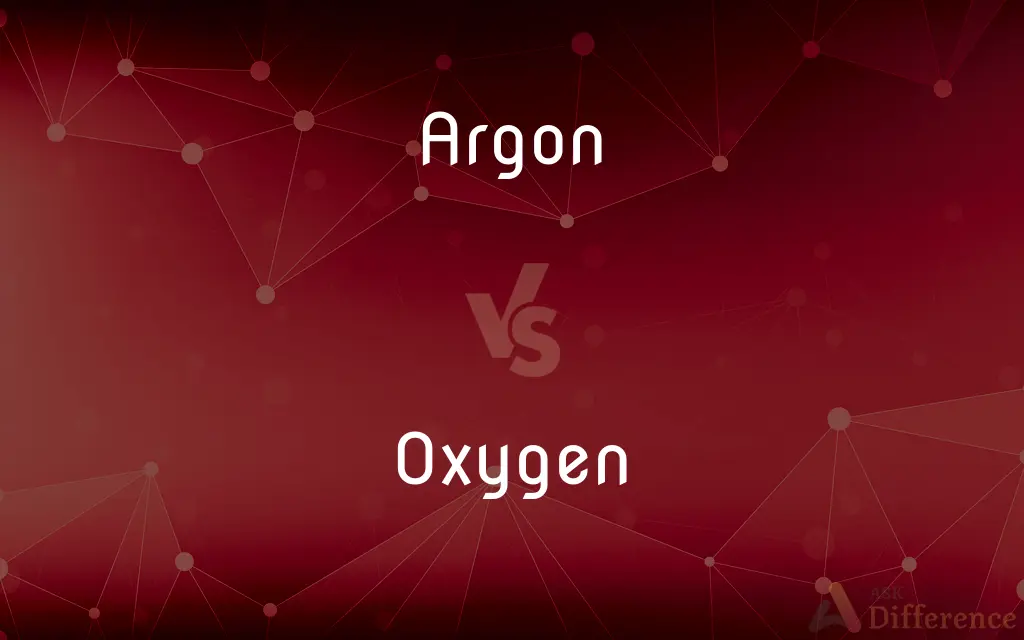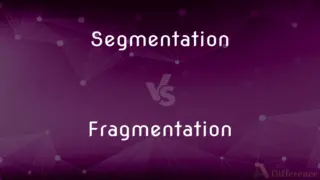Argon vs. Oxygen — What's the Difference?
Edited by Tayyaba Rehman — By Fiza Rafique — Updated on September 27, 2023
Argon is a noble gas and colorless, while oxygen is a diatomic molecule vital for life and supports combustion.

Difference Between Argon and Oxygen
Table of Contents
ADVERTISEMENT
Key Differences
Argon is an inert gas, meaning it doesn't readily react with other elements, while oxygen is highly reactive and essential for many chemical processes, including combustion.
Both argon and oxygen are elements found in the Earth's atmosphere. However, while oxygen makes up about 21% of the atmosphere and is crucial for aerobic life, argon constitutes about 0.93% and has no biological role.
Argon belongs to the noble gas group in the periodic table and is characterized by its full valence electron shell, resulting in its low reactivity. In contrast, oxygen is a member of the chalcogen group and is known for its ability to form double bonds, which makes it essential in compounds like water.
Welders often use argon as a shielding gas because of its inert properties, ensuring no unwanted chemical reactions occur during the welding process. Oxygen, on the other hand, is used in medical treatments and to support combustion in various industrial processes.
While argon is mainly used for industrial purposes, like in lighting and welding, oxygen has broader applications, including medical, industrial, and environmental, given its importance in respiration and combustion.
ADVERTISEMENT
Comparison Chart
Group in Periodic Table
Noble gases
Chalcogens
Atmospheric Percentage
Approx. 0.93%
Approx. 21%
Reactivity
Inert, rarely reacts
Highly reactive
Biological Role
None
Essential for aerobic life
Common Uses
Welding, lighting
Combustion, respiration, medical treatments
Compare with Definitions
Argon
A noble gas with the atomic number 18.
Argon-filled lamps are energy-efficient.
Oxygen
Constitutes about 21% of Earth's atmosphere.
Oxygen supports life on Earth.
Argon
Heavier than oxygen and colorless, odorless, and tasteless.
Argon is often used in applications where a non-reactive atmosphere is needed.
Oxygen
A diatomic molecule with the formula O₂.
Without oxygen, humans cannot survive for long.
Argon
A component of Earth's atmosphere.
Argon makes up a small fraction of the air we breathe.
Oxygen
Highly reactive and forms compounds with most elements.
Oxygen combines with hydrogen to form water.
Argon
An inert gas with low reactivity.
Due to its non-reactive nature, argon is used in welding.
Oxygen
Essential for combustion and respiration.
Fires need oxygen to burn.
Argon
Used in lighting due to its non-reactive properties.
Argon-filled bulbs have a longer lifespan.
Oxygen
Oxygen is the chemical element with the symbol O and atomic number 8. It is a member of the chalcogen group in the periodic table, a highly reactive nonmetal, and an oxidizing agent that readily forms oxides with most elements as well as with other compounds.
Argon
Argon is a chemical element with the symbol Ar and atomic number 18. It is in group 18 of the periodic table and is a noble gas.
Oxygen
A colourless, odourless reactive gas, the chemical element of atomic number 8 and the life-supporting component of the air.
An oxygen supply
If breathing stops, there is no oxygen getting to the brain and the cells begin to die
Hydrogen and carbon in the fuel combine with the oxygen in the air to form carbon dioxide and water
Argon
A colorless, odorless, inert gaseous element constituting approximately one percent of the earth's atmosphere, from which it is commercially obtained by fractionation for use in electric light bulbs, fluorescent tubes, and radio vacuum tubes and as an inert gas shield in arc welding. Atomic number 18; atomic weight 39.948; melting point -189.36°C; boiling point -185.85°C. See Periodic Table.
Oxygen
A nonmetallic element constituting 21 percent of the atmosphere by volume that occurs as a diatomic gas, O2, and in many compounds such as water and silica, and in iron ore. It combines with most elements, is essential for plant and animal respiration, and is required for nearly all combustion. Ozone, O3, is an allotrope of this element. Atomic number 8; atomic weight 15.9994; melting point -218.79°C; boiling point -182.9°C; gas density at 0°C 1.429 grams per liter; valence 2. See Periodic Table.
Argon
The chemical element (symbol Ar) with an atomic number of 18. The third most abundant gas in the Earth's atmosphere, it is a colourless, odourless, inert noble gas.
Oxygen
The chemical element (symbol O) with an atomic number of 8 and relative atomic mass of 15.9994. It is a colorless and odorless gas. Category:en:Oxygen
Argon
(countable) A single atom of this element.
Oxygen
Molecular oxygen (O2), a colorless, odorless gas at room temperature, also called dioxygen.
Argon
A colorless, odorless gas occurring in the air (of which it constitutes 0.93 per cent by volume), in volcanic gases, etc.; - so named on account of its inertness by Rayleigh and Ramsay, who prepared and examined it in 1894-95. Symbol, A; at. wt., 39.9. Argon is condensible to a colorless liquid boiling at -186.1° C. and to a solid melting at -189.6° C. It has a characteristic spectrum. No compounds of it are known, but there is physical evidence that its molecule is monatomic. Weight of one liter at 0° C. and 760 mm., 1.7828 g.
Oxygen
(medicine) A mixture of oxygen and other gases, administered to a patient to help them breathe.
Argon
A colorless and odorless inert gas; one of the six inert gases; comprises approximately 1% of the earth's atmosphere
Oxygen
(countable) An atom of this element.
Oxygen
(figurative) A condition or environment in which something can thrive.
Silence is the oxygen of shame.
They hoped to starve the terrorists of the oxygen of publicity.
Oxygen
A colorless, tasteless, odorless, gaseous element of atomic number 8, occurring in the free state in the atmosphere, of which it forms about 23 per cent by weight and about 21 per cent by volume, being slightly heavier than nitrogen. Symbol O. Atomic weight 15.9994.
Oxygen
Chlorine used in bleaching.
Oxygen
A nonmetallic bivalent element that is normally a colorless odorless tasteless nonflammable diatomic gas; constitutes 21 percent of the atmosphere by volume; the most abundant element in the earth's crust
Oxygen
Used in medical treatments as a respiratory aid.
Oxygen tanks are common in hospitals to assist patients with breathing.
Common Curiosities
Why is oxygen important for humans?
Oxygen is vital for cellular respiration and energy production in humans.
Is it safe to breathe argon?
No, argon is not toxic, but it can displace oxygen and lead to suffocation if inhaled in large amounts.
Can argon support combustion?
No, argon cannot support combustion, unlike oxygen.
Why is argon used in light bulbs?
Argon is used because it is inert and prevents filament oxidation, prolonging bulb life.
Why is oxygen used in welding?
Oxygen supports combustion and enhances the welding flame's temperature.
Can oxygen be seen or smelled?
No, oxygen is colorless and odorless.
Is argon a reactive gas?
No, argon is inert and does not react readily.
Which gas is more abundant in the atmosphere, argon or oxygen?
Oxygen is more abundant, making up about 21% of the atmosphere.
Are both argon and oxygen colorless?
Yes, both gases are colorless, odorless, and tasteless.
How is argon obtained for industrial uses?
Argon is obtained through the fractional distillation of liquid air.
Share Your Discovery

Previous Comparison
Segmentation vs. Fragmentation
Next Comparison
Equality vs. DiversityAuthor Spotlight
Written by
Fiza RafiqueFiza Rafique is a skilled content writer at AskDifference.com, where she meticulously refines and enhances written pieces. Drawing from her vast editorial expertise, Fiza ensures clarity, accuracy, and precision in every article. Passionate about language, she continually seeks to elevate the quality of content for readers worldwide.
Edited by
Tayyaba RehmanTayyaba Rehman is a distinguished writer, currently serving as a primary contributor to askdifference.com. As a researcher in semantics and etymology, Tayyaba's passion for the complexity of languages and their distinctions has found a perfect home on the platform. Tayyaba delves into the intricacies of language, distinguishing between commonly confused words and phrases, thereby providing clarity for readers worldwide.
















































